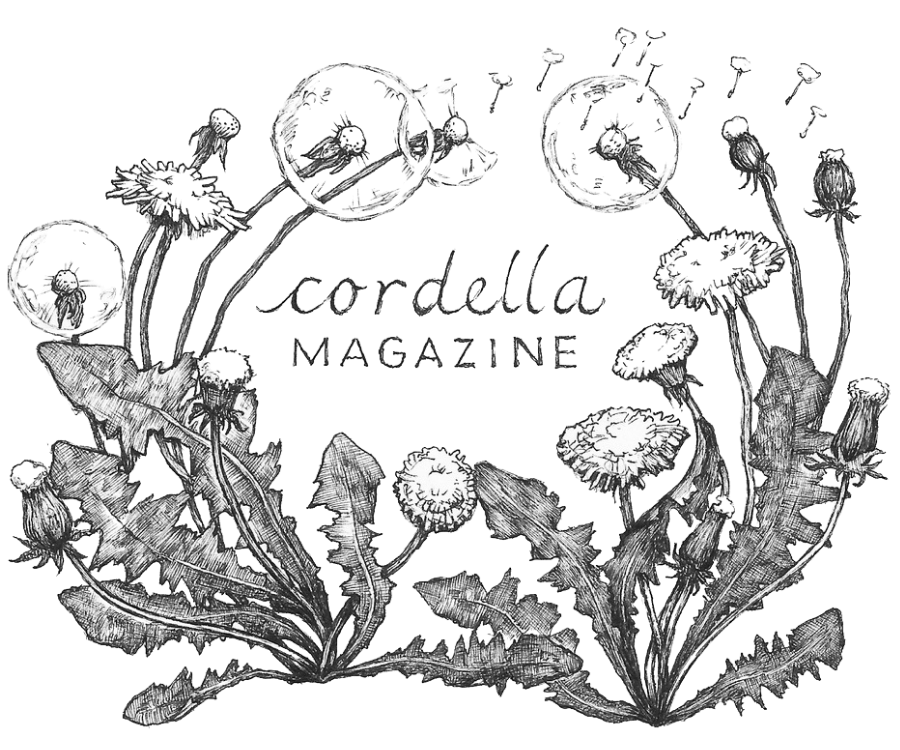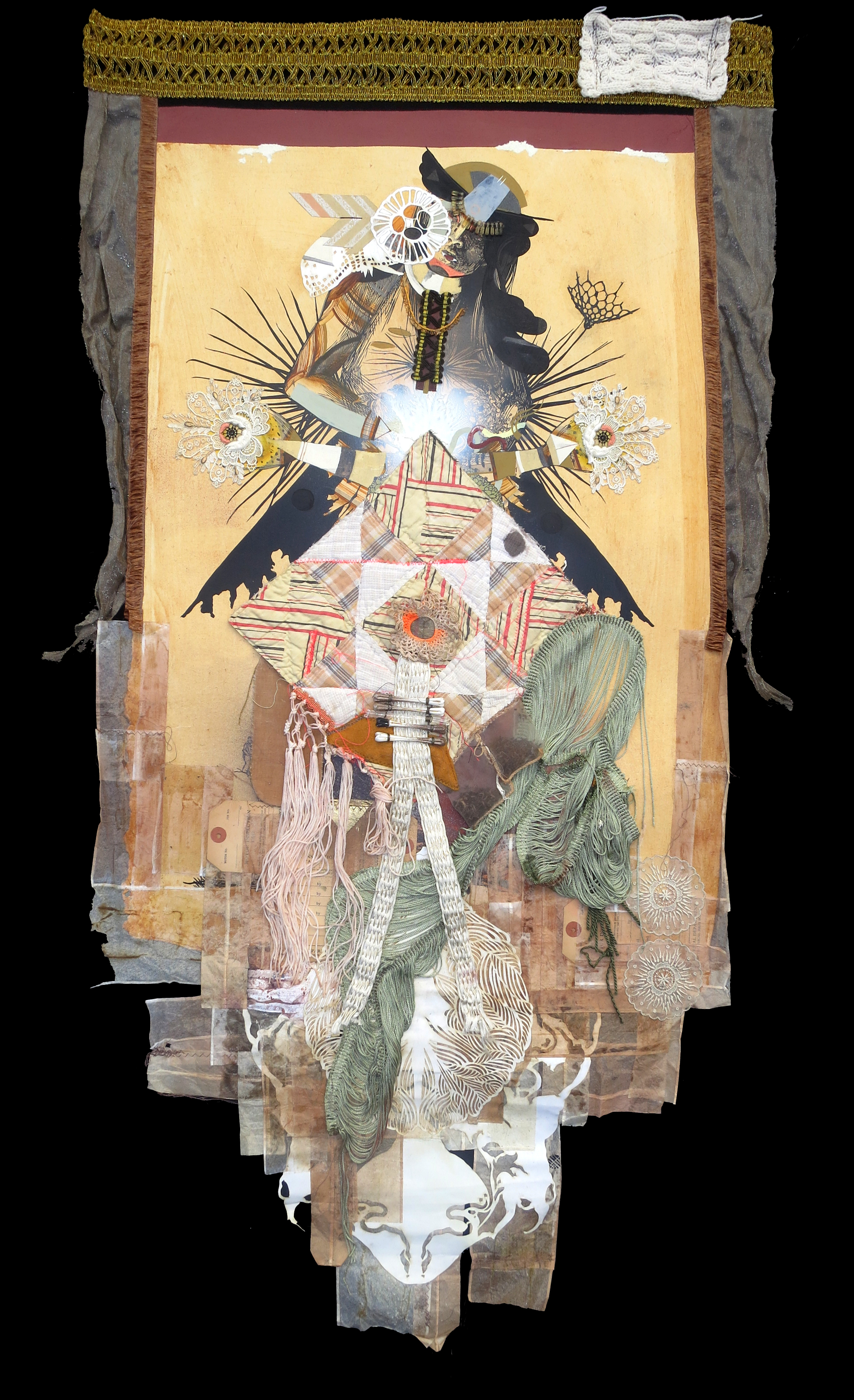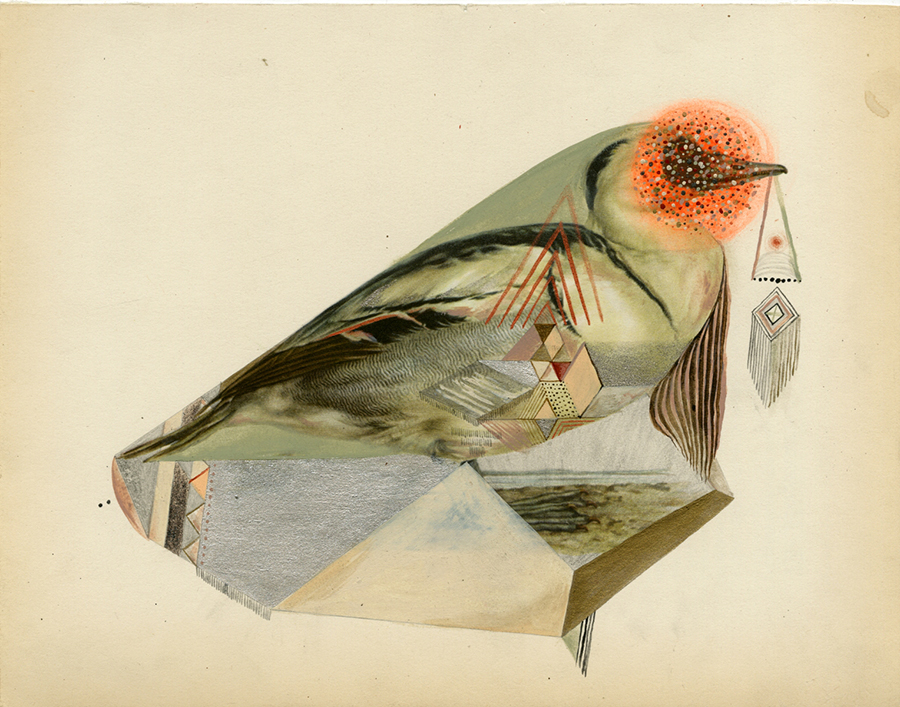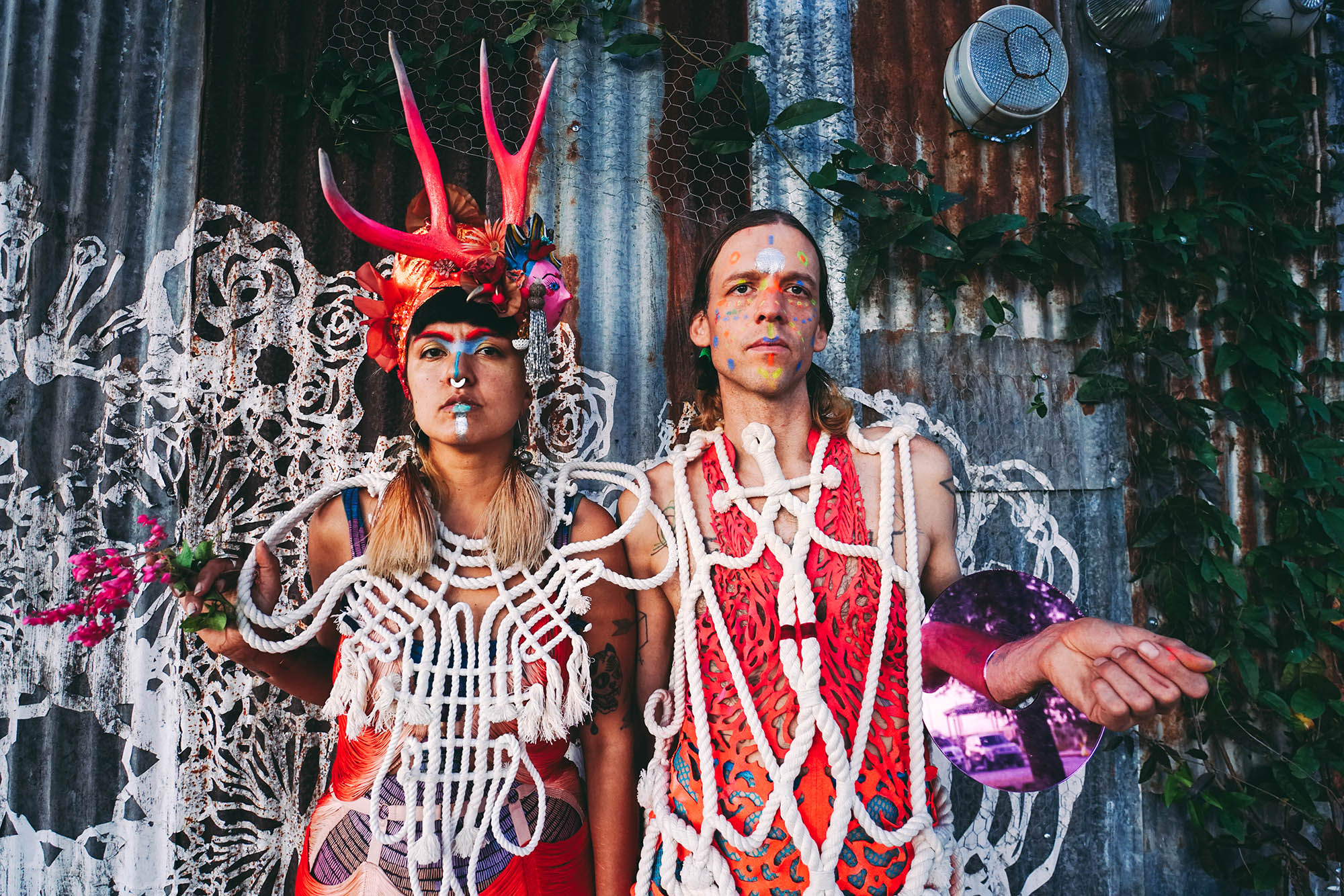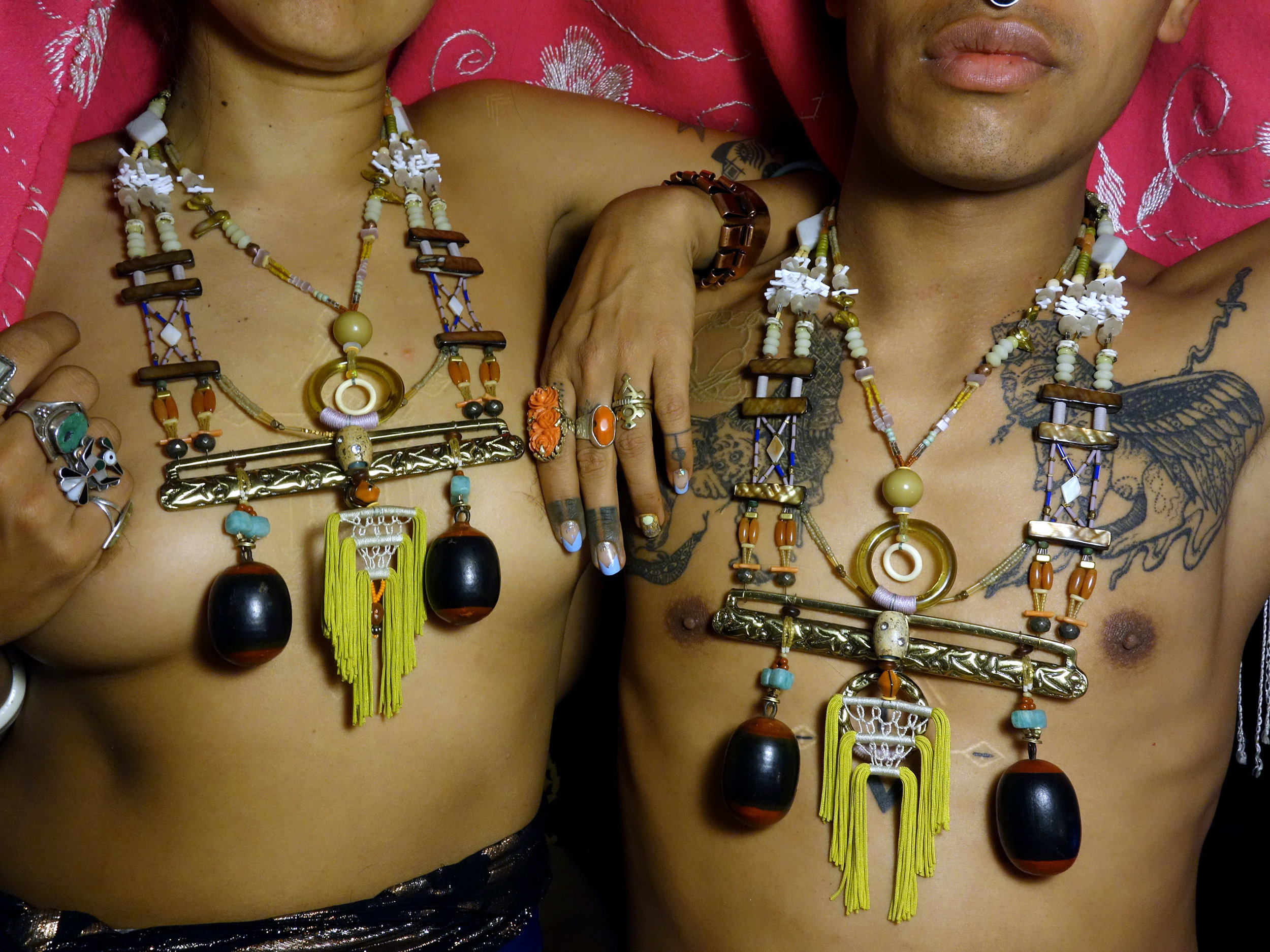A LIVING HISTORY
An interview with Monica Canilao
Home Mender, image by Tod Seelie
Monica Canilao is an interdisciplinary artist whose work shifts and flexes with the elements of landscape and time. Working with paint, found objects and recycled materials from America’s industrial junk store, Monica creates other-worldly installations and murals along with fantastical wearable pieces. Erica Faison, Cordella’s new Slow Fashion Editor, had a conversation with Monica regarding her work as an artist with a focus on her work in the slow fashion movement.
Erica Faison: Your wearable works often have a beauty which feels sacred and ceremonial. What inspires you? What intentions are in mind when you create a new piece?
Monica Canilao: There is power in ceremony. Keeping up a life which completely revolves around my art practice involves ceremony. There is power in objects and wearables made with intention. The energy which goes into creating a thing I believe can be transferred both into the onlooker and the wearer. For as long as I can remember I have altered clothing and decorated, because I never felt good in a white room or to wear regular clothes. I couldn’t afford fancy fun clothes and so I made them myself.
I have been making jewelry and costume pieces for many years, for my personal use and for my friends, and now I regularly make one-of-a-kind jewelry pieces and wearables for others as well. I primarily use recycled, found, flea-market-scored, thrifted and gifted elements throughout my art practice. I never repeat a design and I prefer to make things custom for people when I can. I stray away from mass production of any kind because it often feels disingenuous, and if I am going to make something, why would I repeat a design when I can make something new? I like the idea of only one of something existing, and once it finds it’s right home I’ve completed a full circle with the energy I put into it.
The act of adorning the body in elements that make you feel powerful, proud, tell a story, or express yourself can lift up the spirit of a person. I make a sort of power jewelry out of many kinds of materials I gather from all over, and the materials I collect as a journal of what I have seen and where I have been. Recycling is a form of preservation. The last thing this world needs is more disposable things.
See No Evil
Erica: What aspects of your art excite and reward you the most?
Monica: The most touching part of being a creator is when my work genuinely makes a difference in someone's life. I try and respond to as many people as I can that reach out. I have talked down youth I didn’t know from committing suicide. I have given advice to countless kids and peers asking for help on all kinds of subjects over the years. I try to take my role as a public voice and influencer very seriously.
A few years ago I went to the Navajo Nation to do the Painted Desert project, and with my friend, Nick Mann, I painted and built a new roadside food stand for the Woodys, a family on the reservation whose previous food stand had burned down in a grease fire. It was the way they made their living and we came together with the community to erect this structure, which was constructed out of wood with painted murals on all sides. We became connected to the community, and the family came to hang out with us as we painted. I showed their kids how to use spray paint and make stencils, we ate food together and formed a bond. The bright murals on the new food stand attract visitors which in turn leads to more business and helps the family to make a living again. Always my favorite—doing something out of love to help others not just survive, but thrive. Skill share and sharing resources...it’s all important.
Erica: Can you tell us about your roots and how your ancestry has imprinted your creations?
Monica: My roots and upbringing have everything to do with my art practice. I come from a family of immigrants and hard workers, creatives and people who do what they can with what they have. I was raised going to second hand stores. My mother is extremely sentimental about heritage and ancestors, things passed down from generations before. I picked up the same obsession with antique and lived-in objects, hand-me-downs and the handmade.
River Woman, Collaboration with Swoon
My father grew up hard on the streets of the Philippines and later worked in construction. In his blood I believe I inherited a survival sense, which I have used over the years to build a life around traveling and building on the fringes, with like-minded freaks and folks who also stray away from a safe, square life. My Filipino, Native American, Russian, French blood has me deeply attracted to intricate, beautiful, traditional dress and imagery which invokes the past lives and presentation of native peoples worldwide. I draw inspiration from the craft I see in book pages and when I dig into the roots of my own ancestors I find so much beauty in the past. My art now is a translation of the world, as I am trying to shape it and translate the now to all the past lives’ work.
Erica: Your processes include recycling and found objects. Do you find the items you seek or do items find you and change your direction? Can you share a story about manifesting found pieces used in your work?
Monica: I have always possessed a side eye that is on the look out for treasure. I frequent flea markets, abandoned buildings and thrift stores, often not searching for anything in particular. Objects find me and, based on what I find or am around at the moment, often dictate what I use in my projects. Whenever I build installations away from home I always source and utilize local materials for two reasons. One, I want what I make to always have a connection to the place I am making it in. And two, I like to see what I can find and then figure out how it can be used as a means to an end when building installations…whether it be with wood or fabric. I alter and dye and paint onto pieces, combine found materials with new structural elements, and they all take on a new life. Working organically is always a surprise.
While working on a post-apocalyptic movie called Orion in Detroit a few years back, every structure and costume had some element to it made form abandoned building refuse. We reclaimed huge vintage parachutes and yards of fabric from trash piles for the backdrop for a lot of the scenes and set dressing. Everything I make has found objects in it. Even the murals I paint, I always prefer buying “oops” paint before dropping money into expensive new enamel. Everything needs to be used somehow…why not source things that are destined for the trash heap. Oh the treasures I’ve found…I can’t even describe how much I hate seeing things go to waste that still have life left in them.
Erica: What does a typical workday in the studio look like for you?
Monica: I don't know if I have a typical workday per say. My days are shaped very differently based on the projects I am working at in the moment, and the range is always vast.
Lately I have been painting many large off site murals in which my working day consists of painting almost non-stop from around 1pm until about 3 or 4am each day. My on-site murals are similar in style except there is travel time, prep for the day, set up and a pack out of materials. Most mornings I check emails and make food for the day. I work out of my home on wearables, where I set up a jewelry work bench in my closet and smaller paintings at the table at the end of my bed. I work in my basement, I work at my studio “The Jewel Box” and do large scale painting at Xara’s studio, and each space has its different types of projects. At any given time I am working on at least five-ten personal projects and from two-six collaborative projects…switching back and forth between them all based on deadlines and mood. I often pack travel-able projects to take with me, so I can have work dates with others or work at the lake or beach. I collaborate on leather wearables with my friend Meremade and we work out of her leather studio.
Merganzer
Murals in the Market
Erica: A portion of your work is done within a community setting. What causes such a community to thrive and what advice would you give others to cultivate and maintain similar community bonds?
Monica: A Community is the most important thing you can put energy into. The definition of community is a feeling of fellowship with others, as a result of sharing common attitudes, interests, and goals. Being a full time working artist would be quite lonely if you didn’t put energy into meeting, collaborating and building relationships with others. The energy you put out comes back to you…and the same goes for support. The advice I would give to anyone working in a creative field (or life in general really) is that if you put in the work to help others when they need it, you will often find it more likely that others will be there for you when you need support. The second thing I believe in is manifestation. If you speak to others about your dreams and ideas, it is usually just a matter of time before someone can connect the dots needed for an idea to take shape. At the base of any community there is the need for people to want to help one another, to connect and to grow.
Erica: Tell us about a challenge that you’ve faced with your business.
Monica: I don't really consider my art practice as a business. I create things in order to thrive and survive, to communicate and connect with others. I make a living off of my practice in its many forms, but the word business, connected to capitalism, feels in so many ways like a dirty word. I take pride in initiating a consistent line of trading with other makers. I see value in the exchange of objects made with intention. I think the connection to others and constant conversation about supporting one another is important. It is always going to be harder to make it in the world as a woman of color. I feel like I often have to work twice as hard to obtain the same resources, opportunities and money as men in the art world. It is frustrating the way I have been spoken to over the years by different people, assuming that I don’t know how to build or carry the same weight as a man. It is a constant act of proving my worth to some higher authority. This is an issue across the board, within every country and in every industry. My solution to inequality is to try and support and hype my fellow creators within the means that I can. Gotta share what ya got.
Monica Canilao
In the heart of Oakland, California, Monica Canilao spends her days stitching, painting, printing, and breathing life into the refuse that dominates our time and place. Moving across media, sometimes with friends and sometimes alone, Canilao makes a delicate visual record of the personal and communal. She received a BFA from California College of Arts and Crafts and has shown in galleries, community spaces, and abandoned places worldwide. See more of her work at monicacanilao.com and wewillallbewelll.com and follow her on Instagram @__moreferalthan__ and @we_will_all_be_well.
